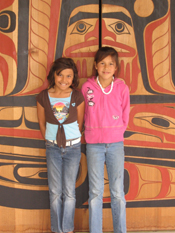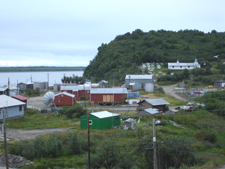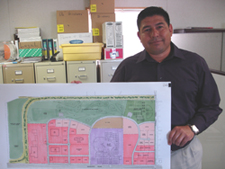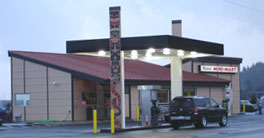2006 Success Stories
Project Title: Recruit, Train, and Certify New Native American Foster Parents
Project Start/End Dates: 9/30/2004 - 9/29/2006
Total Grant Amount: $365,485
The Port Gamble S'Klallam Tribe received a 24 month SEDS grant in 2004 to develop a Tribal foster parent certification program to assist the Port Gamble S'Klallam community in providing care and services for their children based on S'Klallam values. One of the many challenges in providing foster care is the recruitment and retention of foster parents. This is especially true for the Tribe where cultural differences hinder traditional foster parent recruitment efforts. Thus the Port Gamble S'Klallam Tribe implemented a foster parenting agenda focused on the unique needs of their children.
At the time the Tribe submitted the application for this project they had 22 children in out of home placement; all with foster parents not yet certified, leaving caregivers short of resources in which to care for the children. The S'Klallam community takes pride in seeing their children stay connected to the Tribe as they are their future. The first of the project's two objectives was to provide culturally appropriate foster parent training to the Port Gamble S'Klallam Community. This led to the success of the second objective: ensuring that all Tribal children be placed with foster parents in their community. The project has been extremely successful, 42 Tribal members have received Foster Care training and 13 have received certification. All of the 22 children are now living with certified foster parents and receive excellent support. The success of this project has significantly impacted the Port Gamble S'Klallam community.
Pilot Station Community Development Plan
Project Title: Development PlanProject Start/End Dates: 9/30/2004 – 9/29/2006
Total Grant Amount: $109,570
Pilot Station is an Alaska Native Village located on the northwest bank of the Yukon River, within the Yukon Delta National Wildlife Refuge. The relative isolation of the village has presented it with a myriad of issues and constraints to overcome.
On the economic front, over half of the community's population of 550 is under 18 years of age, and 28% of the total population lives below the poverty level. There has therefore been a pressing need to establish a local economic base in order to accommodate the burgeoning population growth. On the environmental front, the homes in Pilot Station have no piped sewage or running water. Honey buckets are hauled to the sewage lagoon, and thus the frequency of water-borne diseases is high. The community's landfill is also not compliant with state regulations: trash is not separated and hazardous materials are disposed of in the same manner as all other garbage, thereby leaching toxins into the water table, heavily impacting the subsistence-based community.
Previously, there was no plan in place to confront these issues. This ANA project implemented a participatory approach to create Pilot Station's first comprehensive Community Development Plan. Community meetings and surveys formed the foundation for the creation of a comprehensive assessment of the current state and a structured set of priorities for its future development. The Pilot Station project staff commendably committed itself to a process in which the beneficiaries of the project influenced and shared control over development initiatives which affect them and the subsequent resource decisions.
At the community level, a forum was created for the sharing of knowledge, and the project encouraged Pilot Station residents to provide input on the development of their community. The community survey enabled greater community involvement in determining priorities which will lead to suitable development considerations. This project therefore provided enlightenment on the concept of self-government and educated the community on how the Pilot Station Traditional Council can serve the needs of Pilot Station. Furthermore, this participatory approach will lend credibility to any future effort by the Pilot Station Council to implement associated development plans. Overall, the community has been empowered, and they have created a set of directions for the growth and progress of their community.
For the Pilot Station Traditional Council, the development and creation of the first Community Development Plan has educated each member on the issues, priorities and concerns of their constituents in a structured, formal way. The desire for a more stable job base and the appeal to improve the sewage lagoon and dump-sites within the village have gathered the most support from community members. The project's implementation has also informed the Council of their responsibility in setting Pilot Station's course for development, including their responsibility to secure the economic resources to meet the stated needs of the community and to protect the village's environmental resources.
One of the challenges faced by Project staff was the initial reponse of skepticism from the older generation; there was a general disbelief that the development of a community plan would lead to the actual implementation of priority-based projects. However, the advent of community meetings and the encouraging number of completed surveys and drop-in requests seem to have brought a different way of thinking to the village. Community members have become more vocal in sharing their personal visions of progress for the village, and this development was evidenced by the community's recent collective request to open a second store in Pilot Station. The Traditional Council has heeded this appeal and is now moving forward with the planning for the community's second store.
The Pilot Station Traditional Council now has clear, current and accurate information about the priorities and concerns of its constituents. A foundation for appropriate policy implementation and project development has therefore been successfully built by this project. Pilot Station as a community is now free to procure further grant funding to realize its vision for progress, and to capitalize upon the environment of empowerment that has been created by this project.
Project Title: Economic Empowerment Project
Project Start/End Dates: 9/30/2004 – 6/30/2006
Total Grant Amount: $177,651
Recent urban development has rapidly overtaken the landscape of the outer boundaries of Arizona's Ak-Chin Community. The city of Maricopa, which abuts Ak-Chin to the north, has more than tripled its population in the past five years, and more development is scheduled. The Ak-Chin Community itself has recently welcomed back 126 Tribal families onto its reservation lands. In order to meet the needs of the growing community and to maximize the opportunity to increase its economic power, the Ak-Chin Tribal Government resolved to make economic development one of its top priorities.
The Ak-Chin Planning and Development Office, with Tribal membership involvement, authored the Tribe's General Plan in 2003. The goals and recommendations of that document were initiated through this ANA grant. The four objectives of the grant centered on the development of Ak-Chin's chief asset: its expansive and geographically advantageous land base. This grant 1) created an Economic Development Plan for the community, 2) designed conceptual Master Plans for commercial and public use areas, 3) developed a Business Board to oversee for-profit enterprises, 4) planned for the expansion of Tribal services to become Tribal enterprises, and 5) laid the groundwork for an entrepreneur program for prospective businesspeople. Additionally, project staff has included within the Economic Development Plan a strategy to direct a portion of the financial gains into social development programs, including expanding current social services available at the Community Center and forming a scholarship fund for Tribal members.
As a result of this grant, the Tribal government now has the master plan designs to begin laying infrastructure in designated areas. The development of Ak-Chin lands will bring jobs to Tribal members and the surrounding population. Ak-Chin members will have the opportunity to become entrepreneurs. New businesses will provide the needed local retail services, and existing Tribal services will have the opportunity to become Tribal enterprises, serving the Ak-Chin people and the launched businesses. In short, the project will allow the Ak-Chin Indian Community to derive benefit from the economic boon already occurring in a booming metropolis.
This project has created foundational pieces that are mutually supportive. Community input demanded design plans which would reflect an active living community and support the economic and social needs of its members. The adoption of the completed plans by Community Council will endorse their suitability and serve as a positive step towards project sustainability. Overall, there is a keen sense of excitement and anticipation within the community. Bart Smith brimmed with enthusiasm when he declared, “Wait until you see this place in 5 years.”
Native Americans for Community Action, Inc.
Project Title: The Ray of Hope Project
Project Start/End Dates: 9/30/2004 – 6/30/2006
Total Grant Amount: $92,809
Alcohol and substance abuse are growing problems amongst Flagstaff 's Native youth. The area also lacked a counseling and treatment program specifically designed for Native American teenagers. Upon noticing this glaring void, Native Americans for Community Action, Inc. (NACA) applied for, and received, a two-year ANA grant in 2004 to implement a social assistance program directed at Flagstaff 's Native 12 to 17-year olds. The project aimed to assist teenagers to develop positive relationships with their families and peers as well as practice healthy lifestyles. Project implementation included substance abuse prevention services, individual and group treatment, continuing care and cultural/spiritual activities. NACA also stressed the need for a strong social network as a preventative and curative measure to substance abuse problems.
NACA has successfully paired Western treatment strategies with traditional Native healing and education by utilizing Talking Circles and sweat lodges in their counseling services. These treatments have helped raise the self-confidence levels of local Native teens, specifically in dealing with peer pressure. The activity was led by Sam Tso, who shared traditional Navajo stories and related them to the clients' current situations. Mr. Tso articulated, “I teach traditional values through traditional stories. Most of these children did not have the opportunity to hear these stories from their families. So I bring life back to their culture and give them the means to help them find their way.”
Due to the success of this project on the community level, Flagstaff now has a viable option for which to refer Native teenagers with substance abuse problems, an option that did not exist before. More specifically, the Juvenile Court Services of Cococino County and the Kinlani Boarding School, which provided the bulk of referrals to the Ray of Hope Project, will continue to have a culturally appropriate substance abuse program available for rehabilitation purposes. Antoinette Jensen, Dorm Manager of the Kinlani Boarding School, stated, “This program has been a lifeline for us. There was a large gap before this program and it is one that has been filled.” David Howard, a Juvenile Probation Officer with the Juvenile Court Services of Cococino County, referred a number of youth to NACA's treatment program, and added, “NACA is one of my first calls because this program works for the teenagers that come through my doors.”
California Indian Museum and Cultural Center
Project Title: Knowledge Circle Project
Project Start/End Dates: 9/30/2004 – 2/28/2006
Total Grant Amount: $401,047
The California Indian Museum and Cultural Center (CIMCC) received a 17-month SEDS grant from ANA in 2004 for their “Circle of Knowledge” Project. CIMCC's goal is to provide all California Indians with a highly visible environment to present their stories, histories and cultures to the public. CIMCC has created multi-media, interactive exhibits at their Museum building in Santa Rosa, CA. The museum has begun to serve California Indians and the general public with alternative viewpoints to mainstream media information while promoting dialogue, facilitating cultural understanding and cross-cultural relationships.
The purpose of the grant was to create the architectural exhibit planning documents and final cost estimates for the museum's living exhibits. The staff did an excellent job carrying out the objectives and activities of the project as they overcame obstacles. CIMCC worked with all 109 Tribes in California and amassed an abundant number of stories, pictures, and other artifacts from all areas of California. These stories and artifacts have been incorporated into the final architectural design.
Project Title: Chehalis Seven Generations Language Project
Project Period: 9/30/2004 – 2/28/2006
Total Award Amount: $174,496
The Chehalis Indian Community received a 17-month ANA grant in 2004 to pursue the preservation of the Chehalis language. The Chehalis Indian Tribe has faced considerable challenges in its efforts to preserve their language. The population of first-language speakers was quickly diminishing, with just four percent of the Tribal population over 64 years of age. Only two fluent Chehalis speakers remained.
In order to assure the language's survival, multi-generational language sharing and acquisition in a classroom setting was deemed crucial. A rudimentary curriculum and Chehalis Dictionary were already in place from an earlier grant; these provided the foundation for implementation of this objective. The strongest and most dedicated students involved in the earlier program were selected to become teacher-trainees and were engaged in intensive language study with the two remaining fluent speakers. With the goal of the project being teacher certification, the trainees were placed in the classroom to work with families that have adopted the language classes as a multi-generational activity. These efforts brought together elders, young adults and youth in the overall goal of preserving the Chehalis language for future generations. 27 language lessons were recorded and transferred to CD format for posterity and for the benefit of those Tribal members who wish to extend the learning environment outside the classroom.
The desire to speak the language of their ancestors as it was originally spoken extends beyond achieving correct pronunciation. As Janet Havelick succinctly expressed, “I am extremely proud to be able to say I am learning my People's language.” Jesse Gleason, one of the teacher-trainees, echoed this sentiment of pride: “This class has given me an opportunity to give life to an almost extinct language and to continue our culture, which is one of the few things that we have left that is truly ours.”
Upon the commencement of this grant, the Chehalis language was at a critical stage. With the ANA-supported phase of the project nearing its end, the students and teacher-trainees were asked to anticipate the future of their language. All understand that the critical stage has not yet passed. However, a mother proudly observed that, “My children are becoming so used to the language, their language, that sometimes they slip into it without thinking.” This recognition provides hope for the future of the Chehalis language and, by proxy, the Chehalis culture.
Project Title: Makah Mini-Mart/Fuel Facility
Project Start/End Dates: 9/30/2004 – 2/28/2006
Total Grant Amount: $471,760
The Makah Tribal Council received a 17-month SEDS grant from ANA in 2004 for their “Makah Mini-Mart/Fuel Facility” project. The project goal was to use ANA grant funds to aid in the creation and start-up of a Tribal enterprise. The funds were used to purchase the necessary inventory, equipment, and to train new employees. The project also included local artist designs on the building's interior and exterior, giving the Makah Mini Mart and Fuel Facility a uniquely “Makah” look.
The Makah Mini-Mart is an economic development project that is part of the Tribe's Comprehensive Plan. The project was designed to provide basic services, generate revenue for the Tribe, and provide jobs for community members. Before the Mini-Mart opened, Tribal members traveled up to 49 miles for banking transactions and over 12 miles for gas and other services such as internet and photocopying. The store opened last year and now provides many needed services in the community, including internet services, photocopying, 24-hour banking(ATM) and gas.
Robinson Rancheria of Pomo Indians
Project Title: Childcare Center Project
Project Start/End Dates: 9/30/2004 – 2/28/2006
Total Grant Amount: $353,760
The Robinson Rancheria of Pomo Indians received a 17-month SEDS grant from ANA in 2004 for their “Childcare Center Project.” The goal of the project was to develop an economically self-sustainable, licensed childcare center. The Center provides childcare services to Tribal families, curriculum instruction, training for parents, and balanced meals to Tribal youth ages 3-5. Prior to the Childcare Project, the nearest childcare center was 20 miles away from the Robinson Rancheria. The opening of the Childcare Center has enabled parents to leave their children in a safe environment on the reservation.
The project began slowly due to difficulties in hiring qualified staff, however once the Childcare Director was hired, the project's objectives and activities were carried out in a timely fashion. The Childcare Center opened its doors to a less then full house but was quickly able to gain the trust of community parents with the help of the Tribal Council. Currently the Center is at maximum capacity and is in the process of expanding the center to accommodate a toddler room. The Childcare Center provides the Robinson Rancheria a safe, happy, and fun environment for children and their families.











